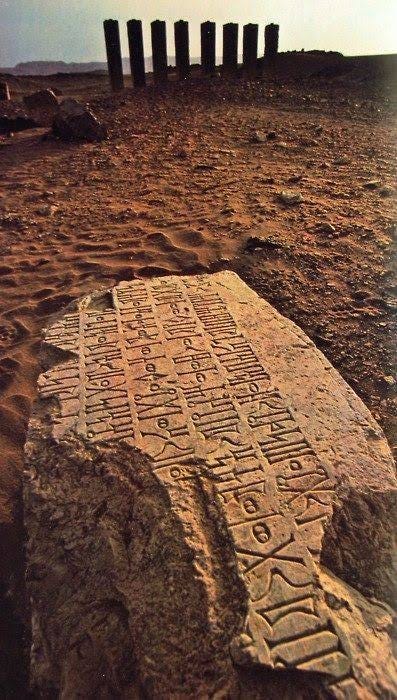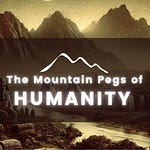In short, Sayyidah Khadijah (AS) invested in the prophetic mission of her husband, the Prophet Muhammad (PBUH), who was born in the Year of the Elephant.
We've seen depictions of the elephant army inscribed on rock...
So far, we've attempted to look at Pre-Islamic Arabia through an objective lens, using both secular and religious references. In the story of Sayyidah Asiyah (AS) and her adopted son, we had the advantage of the Rosetta Stone and other artifacts that correlate with the Qur'an, where it corrects the Bible, but also verifies it where it matters most.
In being proven correct, the Qur'an also provides leverage in disproving biblical denialism. As a result, we Muslims can't deny certain aspects of the Exodus.
Similarly, with Christianity’s Maryam (AS) and her son, the existence of Jesus (PBUH) has been questioned. The Qur'an corrects these misconceptions while also validating the scriptures where it matters most.
Most proof lies in etymology, preserved even by those who oppose religion. The Qur'an is supported by various fields, except where mistranslations (often intentional by the enemies of Islam) create doubt for those who can't understand Arabic.
When it comes to Hadith (reports), there is room for both error and proof. Here, we introduce Dr. Ahmad Jalal, who specializes in epigraphy with inscriptions on stone across the Arabian Peninsula. He explores how these inscriptions can verify or correct early Islamic scholarship. His research requires extensive physical preparation and a deep understanding of Semitic grammar.
The Pre-Islamic world is the final frontier of the great unknown, and much of our information comes from narrations passed down through generations, potentially affected by the "broken telephone" effect.
We know of prehistoric tribes like the people of Madian, Jordan, and Al-Ula associated with Prophet Salih (AS). Here, we can use archaeology and etymology to remove bias from Muslim scholars while validating important truths.
These inscriptions contain poems, prayers, and dedications to the deceased, similar to the ‘Ar Rahiem’ in Surah Al-Kahf, where an inscription holds historical significance. Inscriptions throughout pre-Islamic history highlight important figures and encapsulate the "hadith" or reports of their time.
In post-Islamic Arabia, we have the hadith of the four best women, indicating their superior rank and positioning them as ultimate role models for women. The Qur'an emphasizes the protection and provision of women and children, themes that persist in their stories.
The best way to describe protection is freedom from uncertainty. In the time of Khadijah (AS), women were often forced into marriages, including polyandry, which could confuse paternity and lead to health issues with multiple partners.
From the story of Maryam (AS), we learn the significance of contemplative dhikr focused on Allah (SWT). With the birth of Yahya, we explored the concept of “Kun Fayakun” - Be! And it is! Life force is connected to the Commanded Word. With Eesa (AS), we appreciated that ‘The Healer’ was created in his mother’s womb. The theme of Ali Imran helps us understand the concept of baraka (blessing) from life force energy and its connection to chastity.
In this interview, I mentioned applying for a job and ending up in a brothel. The atmosphere there had a dark energy, opposite to the sense of nur (light) found in the masjid. The women appeared drained, as if they were the walking dead, lacking the baraka that comes from purity. From an afiyah (well-being) perspective, purity leads to baraka, baraka leads to energy, energy leads to healing, and healing leads to health.
Khadijah (AS), known as ‘Taahirah’ (the Pure), had a flag advertising charity because she was sufficient and could give. Other women of her time, who were not sufficient, had flags advertising other services. The entrepreneurial woman could detach from wealth even before Islam, while others were interested in dunya (worldly life) and displayed a lack of decency as a result.
Khadijah (AS) is known as a pure woman, with her skills creating leverage that facilitated her chastity. Other women had no skills or options, only tricks—like a one-trick pony.
In the debate about whether women should work, it's more about whether she’s an employee, self-employed, a business owner, or an investor. It's about income-generating skills that help prevent the fitna (temptation) of compromising values.
Khadijah (AS) had an abundance mindset, while others battled various addictions, with alcoholism being rampant. Addiction is connected to the ‘spirit of lack’—the bottomless void a person feels. Islam brought tawheed (oneness of God) before sobriety, as anyone in active recovery will testify that they couldn’t overcome their addiction without God-consciousness.
Drunkenness in that era was linked to female infanticide, similar to modern population health issues funded by billionaires linked to big pharma. This is justified by saying women become poor or get raped, instead of addressing poverty and sexual assault.
Again, the issues of provision and protection arise. By default, women are expected to have abortions, which have cellular and energetic consequences for them and their future offspring. The elite don’t care that women are starving or attacked; they’re more concerned with results that lead to more trauma and regret, as the majority report.
Back then, men buried their daughters, fearing the stigma of having a defiled woman in tribal warfare. It wasn’t about her well-being but ego. Allah (SWT) describes their attitude as evil, and it still is, as honour killings may be linked to this issue. The man who commits this type of crime sees the woman as an extension of himself, like his “god”—this cultural practice is blatant jahiliyah (ignorance).
I’m not anti-patriarch, but the problem lay in the lack of matriarchal rahma (mercy) and the balance that comes into society through feminine diversity. It’s easier to have an unmoved heart with the yaqeen (certainty) that there will always be justice. Death is freedom from suffering, except for the unrepentant deviations we carry.
In the background of Lady Khadijah (AS), her people, the Arabs, were known for their hospitality, much like Ibrahim (AS) and other Semitic people linked with nomadic culture. Nomadic existence creates a sense of anxiety in the host, as hospitality becomes a matter of life and death for some. We see this with local people descended from those who have ‘trekked’ more than other local tribes or nations, carrying forward a sense of urgency in catering to guests in their homes.
The people of Khadijah (AS) were also known for their honour and follow-through, unlike our local Capetonian flip-flopping. They had dignity and cared about their reputation. These people were very pure from colonization. This is appreciated after having looked at Maryam (AS) in her mihrab, built by her uncle, and the seemingly insulated legacy of Ali Imran.
This lack of colonialism among indigenous Arabs is further proof that this was not Petra, which was dominated by Rome.
“Petra was officially annexed by the Roman Empire in 106 AD, during the reign of Emperor Trajan, who integrated the Nabataean Kingdom, of which Petra was the capital, into the Roman Empire as part of the province of Arabia Petraea. During the time of the Prophet Muhammad's birth in 570 CE, Petra was under the control of the Byzantine Empire. After the Romans annexed Petra, it remained part of the Roman Empire until the Byzantine Empire took control. Petra continued to be part of the Byzantine Empire well into the 6th and 7th centuries.”
While some fools claim that the original ‘qibla’ was in Petra, there's nothing in any hadith that describes the people or culture of either the Romans or Byzantines. As for the Nabataeans, the Prophet (PBUH) and many people of their time were illiterate for a reason:
“During this time, Petra and the Nabataeans were under Byzantine influence, and the Nabataean script was already well-established and evolving into the early forms of the Arabic script. This period might have seen the continued use of the Nabataean script, particularly in regions like Petra, or it might mark a significant point in the transition from Nabataean to early Arabic script.
The Nabataean script, which evolved into the Arabic script, began influencing the Arabian Peninsula around that time. The full adoption and adaptation of this script in regions like Mecca might have occurred closer to the late 5th and early 6th centuries CE, which aligns with the timeline just before the birth of Prophet Muhammad (PBUH).
Therefore, it's plausible that the script became more widely used in Mecca and surrounding areas around 50 years before his birth, contributing to the development of what would become the Arabic script.
During the time of Prophet Muhammad (PBUH), literacy was not widespread in the Arabian Peninsula. The script that eventually became the Arabic script was still relatively new to the region, and formal education was limited. As a result, many people, including the Prophet himself, were not literate. Prophet Muhammad (PBUH) is described as "unlettered" (referred to as "Ummi" in Arabic), meaning he did not read or write. This is significant in Islamic tradition because the Qur’an was revealed to him orally by the Angel Jibreel (Gabriel) and he recited it from memory. His lack of formal literacy is often highlighted as a testament to the divine nature of the Qur’an, as it was revealed to someone who could not have composed it by conventional means.”
Through inscriptions and historical evidence, we'll examine the actual landscape of Khadijah AS. Her actions and sacrifices continue to inspire and guide us today, particularly in an era where the core values of Islam are often challenged.
Join us as we uncover the profound lessons from her life, offering insights that remain relevant for Muslims navigating the complexities of the modern world.
So listen to ‘The Ultimate Legacy & The Inscriptions’ (of Khadijah AS) in this podcast: where we delve deeper into the life, contributions, and timeless influence of this great woman:
#KhadijahAS #IslamicHistory #PropheticLegacy #SpiritualFertility #Inscriptions #Qibla #MakkahNotPetra #IslamicFaith #LawrenceOfArabia #SelflessGiving #AntiColonialism #IslamicLegacy #Podcast
We are now transitioning...
From
'The Direction of Khadijah AS'
to her daughter Fatima AS
Soon, we will find ourselves in
'The Element of Fatima'
(The Maternalist Quartet Series)
Listen to the interview now on our podcast:
The Inscriptions We Leave Behind and The Ultimate Legacy
Finding our Direction
to Allah SWT
with the Best of Women
🌍🌎🌏🧭🕋🧭🌏🌏🌎
#iman #deen #Khadijah #directions #Mecca #ProphetMuhammadﷺ #qibla #legacy #sadaqah #Quran #hadith #desert #inscriptions #prehistoric #preIslam #ancient #history #ancienthistory #Arabic #Fatima #Islam
Subscribe to The Maternalist Quartet channel on YouTube:
















